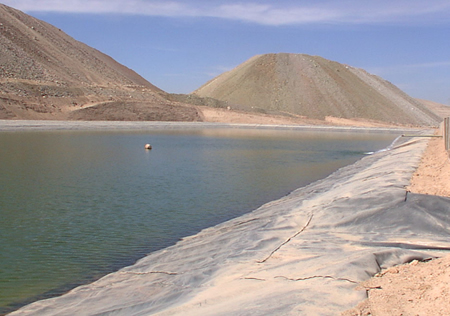


When GeoAmericas 2016 convenes in April in Miami, one of its cornerstone topics will be mining engineering. The scale of mines has increased dramatically in the past decade, which has elevated the need for geosynthetics. The many ways in which geosynthetics help provide safer, stronger yields while enabling more cost-effective approaches—including for some staggering engineering—will be on full display at GeoAmericas.
The event is the 3rd Pan-American Conference on Geosynthetics and it takes place 10 – 13 April 2016 at the Loews Miami Beach Hotel. Registration is now open.
Geosynthetics and Mining Engineering
For mine engineers and owners, geosynthetics provide cost-effective solutions to the geotechnical challenges on site as well as a number of productivity-increasing benefits. With regards to the environmental concerns that mines must deal with, geosynthetics can provide enhanced long-term barrier performance, decrease the strain on water resources, reduce site erosion, and control discharge.
Just as geosynthetics are used to cap and repair contaminated soils at old mines, they provide upfront, forward-looking protections and stronger returns for active mines.
Despite the full scope of utilization in this sector, mining discussions have only recently incorporated geosynthetics. This makes the offerings at GeoAmericas even more important. Almost without recognition by geotechnical or mining professionals, the mining industry has come to use up to 40% of the annual, global production of geomembranes. (Heap leach operations are the major driver here.) The first major conference dedicated exclusively to geosynthetics in mining wasn’t held until late 2014. Even renowned barrier research facilities, such as the GeoEngineering Centre at Queen’s University in Kingston, Ontario, Canada have only looked closely at mining and geosynthetic materials for a handful of years.
GeoAmericas gives mining engineering professionals 3.5 days of high-quality short courses, technical sessions, panel discussions, training lectures, keynote addresses, and networking in a sold out international exhibit hall.
Highlights for Mining Professionals
Attendees of GeoAmericas will learn why soil reinforcement is more important than ever to the success of mining and how geosynthetic liners and covers have dramatically and beneficially changed the economics and performance of heap leaching for gold, copper, uranium, and other materials. Participants will be presented with ready-to-use strategies and access to geosynthetic designers, suppliers, and installers who are present and active throughout the Americas.
Highlights:
- A full-day short course on “Advances in Geosynthetics for Heap Leaching,” taught by mine designer and owner Mark Smith, M.Sc., P.E., D.GE (RRD International); Denys Parra, M.Sc., P.E. (Anddes Associados), and Abigail Beck, M.Sc., P.E. (TRI Environmental). This full day course will provide attendees with design insights that will allow them to effectviely understand and incorporate important new technologies in their projects.
- 12+ presentations across two mining and energy technical sessions
- A construction quality assurance (CQA) panel discussion
- Training lectures on barrier system performance; embankments on soft soils; and geosynthetic clay liner (GCL) performance
- Keynote lecture by Dr. Robert Koerner on “Lifetime Predictions of Exposed Geotextiles and Geomembranes“
- Affiliated technical sessions focused on soil reinforcement and ground improvement (37 presentations), barrier design (19), testing of geosynthetic materials (17), drainage and filtration (15), and sustainability (7)
- Access to manufacturers and service providers who supply to mining projects from northern Canada to the southern tip of Chile.
Materials of focus include:
- Geogrids and how they efficiently improve the integrity of unpaved access roads to prevent costly failures under heavy loads and in poor weather.
- Geomembranes and how they increase the yield and flow from heap leach pads and liquor trenches.
- Geotextiles, geocomposite drainage materials, geosynthetic clay liners, geocells, and related materials and how they perform vital functions, enhance drainage and venting, improve the stability of berms around tailings, and much more.
**
Full information, including registration, venue, social/networking functions, and more can be found at www.GeoAmericas2016.org.
RELATED:
- Floating Covers, Evaporation and Mine Economics
- Geomembranes in Mining: The State of Research
- The Rise of Raincoat Liners in Mining
- Geosynthetics in Mining Applications: Reinforcement
- Geosynthetics in Mining Applications: Containment
- NAUE Publishes Mining and Geosynthetics Document
- Mining: Geosynthetic Ballast System Protects Primary Liners
- VIDEO: Geosynthetic Containers in Mining and Mineral Processing
- Solmax Publishes Mining Solutions Magazine











